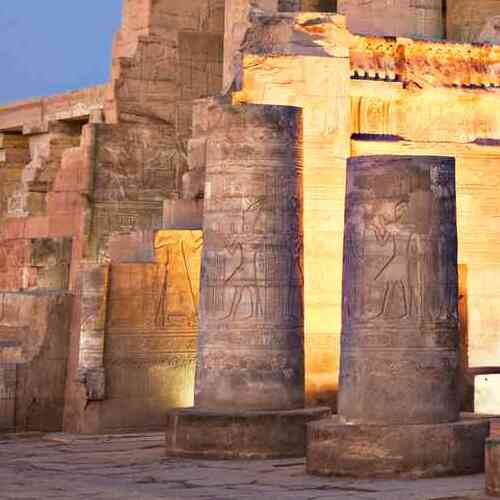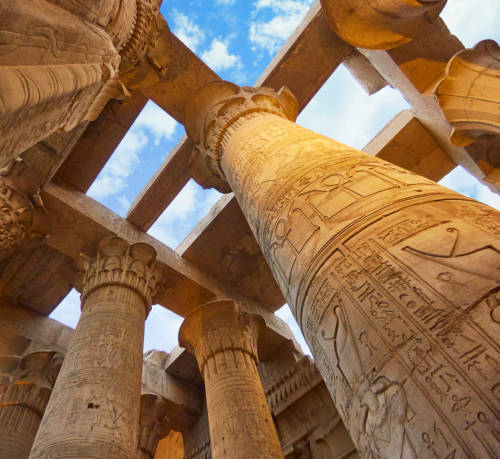No other nation in the world says ‘Welcome’ as often as the Egyptians, and every time, they mean it. While the ancient civilization of Egypt continues to amaze, contemporary Egyptians are equally remarkable.
Ancient Temples
Discovering Kom Ombo's Enigmatic Past
In the heart of Egypt’s timeless landscape, where the fertile and meticulously irrigated sugar-cane fields sprawl, lies the ancient town of Kom Ombo. Tucked away 65 kilometers to the south of Edfu, this picturesque haven not only nurtures the original community of fellaheen, humble peasant farmers deeply rooted in their ancestral soil, but also extends its embrace to a thriving population of Nubians, forced from their homelands by the majestic creation of Lake Nasser. Kom Ombo, with its serene beauty and historical significance, stands as a charming oasis easily accessible to those journeying between the captivating cities of Aswan and Luxor.
A Riverside Marvel: The Temple of Horus and Sobek
In the heart of Egypt’s timeless landscape, where the fertile and meticulously irrigated sugar-cane fields sprawl, lies the ancient town of Kom Ombo. Tucked away 65 kilometers to the south of Edfu, this picturesque haven not only nurtures the original community of fellaheen, humble peasant farmers deeply rooted in their ancestral soil, but also extends its embrace to a thriving population of Nubians, forced from their homelands by the majestic creation of Lake Nasser. Kom Ombo, with its serene beauty and historical significance, stands as a charming oasis easily accessible to those journeying between the captivating cities of Aswan and Luxor.
In epochs long past, Kom Ombo bore the name “Pa-Sebek,” an homage to the crocodile god Sobek, who held dominion over these fertile lands. However, its true grandeur was unveiled during the illustrious Ptolemaic period. Under the reign of Ptolemy VI Philometor, the town underwent a transformation, shedding its former identity to embrace the appellation “Ombos” and ascend to the esteemed position of the capital of the first Upper Egyptian nome.
A Nexus of Power and Commerce
Kom Ombo’s historical significance reached far beyond its serene facade. It was not merely a quaint town but a strategically significant military outpost and a thriving trading hub that facilitated the exchange of riches between the realms of Egypt and Nubia. Amidst its bustling marketplaces, not only did gold change hands, but an even more intriguing commodity found its place – African elephants. These majestic creatures were procured from the distant lands of Ethiopia, serving as indispensable assets for the Ptolemaic rulers in their enduring rivalry with the Seleucids. The need for these elephants was paramount, as they faced formidable adversaries in the form of Indian elephants, champions of the Seleucid Empire, which ruled over the eastern expanse of Alexander the Great’s once-vast domain.
For those seeking to delve deeper into the captivating history of Kom Ombo, a wealth of information awaits, providing a more detailed account of its storied past.
Conclusion: A Sojourn Through the Ages
In the tranquil embrace of modern-day Kom Ombo, surrounded by the rustling sugar-cane fields and the gentle embrace of the Nile, a treasure trove of tales and legacies patiently awaits discovery. From its humble origins as Pa-Sebek, the Land of Sobek, to its transformation into the illustrious Ombos, Kom Ombo stands as an enduring testament to the unyielding spirit of Egypt’s history.
As you stroll through its quaint streets and marvel at the grandeur of the temple dedicated to Horus and Sobek, allow yourself to be transported back in time. Kom Ombo beckons as a captivating journey through the annals of history, where the gods once reigned supreme, empires clashed, and the legacy of this enchanting town was etched into the very fabric of its landscape. So, surrender to the allure of Kom Ombo and embark on a voyage through the captivating mystique of Egypt’s past.
Created On March 18, 2020
Updated On Sept 23, 2024
KOM OMBO Travel Guide



